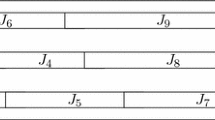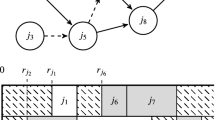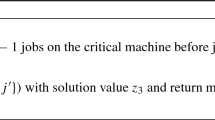Abstract
We consider the following scheduling problem. We are given a set S of jobs which are to be scheduled sequentially on a single processor. Each job has an associated processing time which is required for its processing. Given a particular permutation of the jobs in S, the jobs are processed in that order with each job started as soon as possible, subject only to the following constraint: For a fixed integer \(B \ge 2\), no unit time interval \([x, x+1)\) is allowed to intersect more than B jobs for any real x. There are several real world situations for which this restriction is natural. For example, suppose in addition to the jobs being executed sequentially on a single main processor, each job also requires the use of one of B identical subprocessors during its execution. Each time a job is completed, the subprocessor it was using requires one unit of time to reset itself. In this way, it is never possible for more than B jobs to be worked on during any unit interval. In Braun et al. (J Sched 17: 399–403, 2014a) it is shown that this problem is NP-hard when the value B is variable and a classical worst-case analysis of List Scheduling for this situation has been carried out. We prove a tighter bound for List Scheduling for \(B\ge 3\) and we analyze the worst-case behavior of the makespan \(\tau _\mathrm{LPT}(S)\) of LPT (longest processing time first) schedules (where we rearrange the set S of jobs into non-increasing order) in relation to the makespan \(\tau _o(S)\) of optimal schedules. We show that LPT ordered jobs can be processed within a factor of \(2-2/B\) of the optimum (plus 1) and that this factor is best possible.
Similar content being viewed by others
References
Braun O, Chung F, Graham RL (2014a) Single processor scheduling with time restrictions. J Sched 17:399–403
Braun O, Chung F, Graham RL (2014b) Bounds on single processor scheduling with time restrictions. In: Fliedner T, Kolisch R, Naber A (eds) Proceedings of the 14th International Conference on Project Management and Scheduling, pp 48–51
Garey MR, Johnson DS (1979) Computers and Intractability: a guide to the theory of np-completeness W.H. Freeman, New York
Graham RL (1966) Bounds for certain multiprocessing anomalies. Bell Syst Tech J 45:1563–1581
Graham RL (1969) Bounds on multiprocessing timing anomalies. SIAM J Appl Math 17:416–429
Author information
Authors and Affiliations
Corresponding author
Rights and permissions
About this article
Cite this article
Braun, O., Chung, F. & Graham, R. Worst-case analysis of the LPT algorithm for single processor scheduling with time restrictions. OR Spectrum 38, 531–540 (2016). https://doi.org/10.1007/s00291-016-0431-5
Received:
Accepted:
Published:
Issue Date:
DOI: https://doi.org/10.1007/s00291-016-0431-5




